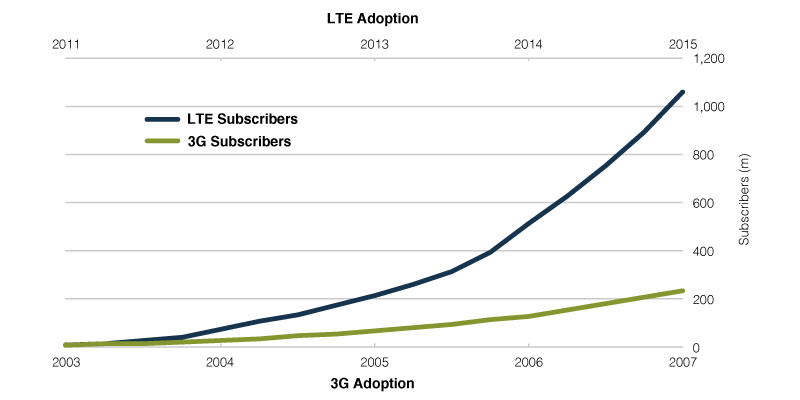The latest figures from TeleGeography’s GlobalComms Database show that 4G LTE subscriptions now account for around 17% of all mobile connections worldwide. LTE passed one billion subscribers just before the end of 2015, and had reached 1.23 billion by the end of March 2016. Just four years ago, however, the total was below ten million. By contrast, 3G technology took twice as long as LTE to go from just under ten million to one billion.
The story is the same when you examine 3G and 4G subscriber growth as a percentage of the overall mobile user total. Around four years after each technology was introduced commercially and roughly two years after rollouts began to become more widespread, both 3G and LTE technologies accounted for around 3% of all cellular subscriptions. Fast forward another twelve months, however, and LTE could claim around 7% of the total, compared to 3G’s 5% at the equivalent date. Another year on, the divide was even more marked, with LTE representing 15% of total users, while 3G had garnered less than half that figure.
One of the reasons behind LTE’s rapid take-up has been that operators have been free to expand their new 4G networks at a quicker rate. This is partly because 4G-suitable spectrum was typically much less expensive than the frequencies acquired in 3G auctions – many of which took place during the telecoms bubble of 1998-2002 – leaving telcos more capital to invest in their LTE rollouts. In addition, 4G networks have been able to attain a wider population coverage much sooner in their development thanks to the use of lower frequency bands, such as 800MHz, which offer a larger footprint than the typical 3G bands, such as 2100MHz.
3G Versus LTE Subscriber Growth

Another reason for the faster adoption of LTE has been the wider availability of 4G-enabled handsets. Early 3G take-up was significantly hampered by a lack of suitable devices and it was some years before the ecosystem grew enough to support real mass-market adoption. This was not the case with 4G, which has seen a much quicker response from device manufacturers.
Perhaps the main factor affecting LTE’s early popularity compared to that of 3G was the fact that mobile users in the 4G era already had an understanding of, and voracious appetite for, data services and apps. This demand was largely missing for 3G initially, a period when developers were working not just to market a new technology but also the host of new applications and services that it would allow the consumer to access.
In markets such as the US and China, 4G services have been met with remarkable success in a relatively short period of time, and it appears likely that 4G take-up will continue to outstrip the comparative post-launch growth of 3G.
Pete Bell
Pete Bell is a Senior Analyst for TeleGeography’s GlobalComms Database and also contributes to the daily CommsUpdate newsletter. He has a particular interest in wireless broadband and was responsible for TeleGeography’s 4G Research Service until it was integrated into GlobalComms.


